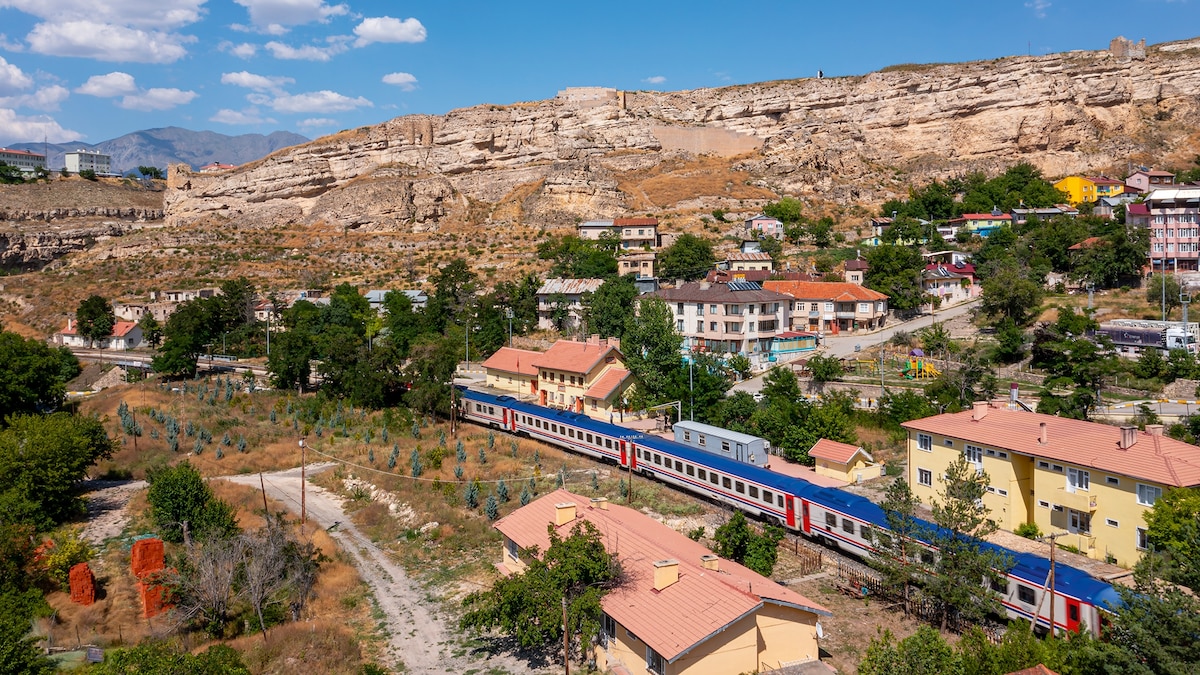7 of the best train journeys in Turkey
4 min read
This article was produced by National Geographic Traveller (UK).
Turkey’s rail network remains one of the country’s best-kept tourism secrets, still rarely utilised by foreign travellers. A fast YHT (high-speed) network connects Istanbul with Eskişehir, Konya, Ankara and Sivas, but it’s the network’s older routes, cutting through rural Turkey, where it really shines for scenic, slow-travel journeys. Most routes open for bookings 30 or 15 days in advance.
1. Roses Express: İzmir to Isparta
This daily train is the prime route for classical history lovers. In total, it’s a 10-hour chug across the coastal Aegean plains and into the hill country of western Anatoli — but the joy is in hopping off periodically to explore the region’s ancient ruins. The train calls into Selçuk station, three miles east of the UNESCO-listed Ephesus ruins, and Denizli station, jumping-off point for Pamukkale’s travertine terraces and Hierapolis ruins. Its final destination, Isparta, is the gateway to the mountaintop ruins of Sagalassos. Tickets 320 TRY (£7.60).
2. Eastern Express: Ankara to Kars
The daily Eastern Express runs for 814 miles across high plateaus and the mountainous countryside of northeast Anatolia. During winter, when snow blankets the peaks and plains, this is one of Turkey’s most beautiful journeys. Most travellers board with their own picnic rather than using the basic dining car, settling in for the 26-hour journey in either Pullman seating or four-berth, shared-couchette sleeper compartments. From December to March, there are also three pricier Touristic Eastern Express departures a week, which only have two-berth private sleeper compartments and include stops for excursions in historic cities. Eastern Express tickets 400 TRY (£9.50), Touristic Eastern Express tickets from 6,000 TRY (£143).
3. Taurus Express: Konya to Adana
This passenger train uses the historic railway line blasted through the Taurus Mountains between 1904 and 1918, which scythes across the Cilician Gates mountain pass once crossed by Alexander the Great. Laid out originally to be the northern section of the Baghdad Railway, the line is rimmed by steep, forested slopes and deep gorges, via multiple tunnels, and travels over the 320ft-high stone Varda Viaduct, which featured in the 2012 Bond film Skyfall. The seven-hour, daily Taurus Express connects Konya with Adana, a good springboard for the castles and ruins of Turkey’s eastern Mediterranean. Tickets 200 TRY (£4.80).
3. Pamukkale Express: Eskişehir to Denizli
Connecting the vibrant arts-hub city of Eskişehir with Denizli for Pamukkale and Hierapolis, the nine-hour Pamukkale Express is a ringside seat for the rural heartland of northwest Anatolia. The northern section trails through valleys once ruled by the Iron Age Phrygian kings, while continuing south the landscape unfurls into wide areas of farmland backed by fir-forested hills. There are daily morning departures in both directions. Tickets 280 TRY (£6.70).
5. Lake Van Express: Ankara to Tatvan
There are two long-distance routes that make the most of southeast Anatolia’s vistas of raw, rock-pitted plateaus, rolling hills, vast lakes and sprawling orchards and farmland. Both cross the Karakaya Dam section of the Euphrates River via the 2,030-metre-long Euphrates Railway Bridge and are at their most scenic in spring and autumn. As on the Eastern Express, the dining car is basic, so most passengers pack their own food supplies for onboard picnics.
The twice-weekly Lake Van Express rolls for 775 miles on its 26-hour journey between Ankara and Tatvan, on the western edge of Lake Van. The lake (Turkey’s largest) sprawls for 1,435sq miles. Head to the city of Van, the springboard to exploring the country’s southeastern corner, and visit Lake Van’s prime attraction, the Armenian artistic masterpiece that is Akdamar Church. Travellers can choose between Pullman seating, four-berth shared couchette compartments and two-bed private sleeper cabins. Tickets from 420-1,590 TRY (£10-38).
6. South Express: Ankara to Diyarbakır
Meanwhile, the South Express meanders for 653 miles between Ankara and the walled city of Diyarbakır, which, with its ancient monuments, Kurdish culture and historic bridges spanning the Tigris River, serves as an excellent introduction to the rich heritage of the south east. The regular 22-hour version, which runs five times a week, costs a fraction of the price of the Touristic Diyarbakır Express — a 24-hour train running the same route, which departs once a month and includes stops for excursions — in the city of Malatya when heading east; and at Yolçatı (to visit Harput Castle), and the city of Kayseri when heading west. South Express seat tickets 355 TRY (£8.45), or 1,525 TRY (£36) for a two-bed private sleeper compartment; Touristic Diyarbakır Express tickets from 8,000 TRY (£191) for a two-bed private sleeper compartment.
7. Sivas-Samsun Railway
This eight-hour route connects the city of Sivas — studded with some of Turkey’s most glorious examples of 13th-century Seljuk-era architecture, with the Black Sea port of Samsun, where the Pontic tomb-haul of golden artifacts known as the Amisos Treasures are finally on display, in the new Samsun Museum. Running three times a week in both directions, the train lazily traverses hills patchworked with farms before winding its way past the Canık Mountains. Slow down and complete it in two stages, stopping in Amasya, where a cliff face dimpled with the tombs of Pontic kings watches over Ottoman houses lining the Yeşilırmak River below. Tickets 275 TRY (£6.50).
To subscribe to National Geographic Traveller (UK) magazine click here. (Available in select countries only).



